8–10 minute read
Principles
Waterwise landscape design is easier for the gardener, conserves water and protects water quality.
Consider the amount of time you wish to spend maintaining the garden. A low-maintenance garden will use mainly woody plants (trees and shrubs) and deep-rooted low-maintenance perennials like ornamental grasses, grouping them in masses. There will be only a few focal perennials.
Low-maintenance planting design: More than just plant selection
Plant factors
Water need
Grouping plants by water need makes irrigation more efficient. To maximize water savings, consider restricting high-water-need plants to a few strategically placed accents or focal points, convenient to a water source.
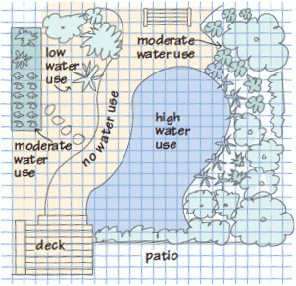 Northern CA Regional Water Authority: Rules of Thumb for Waterwise Gardening
Northern CA Regional Water Authority: Rules of Thumb for Waterwise Gardening
| Water Need | Plantings | Irrigation |
|---|---|---|
| Low | many natives & ornamental grasses | none/rare |
| Medium | roses, deciduous trees | occasional |
| High | lawns, fruit trees | regular |
Root depth
While deeper-rooted plants do not always use less water, they are less dependent on water close to the soil surface. Water near the surface is easily lost to evaporation in the absence of mulch and even with mulch, becomes depleted in the prolonged absence of precipitation.
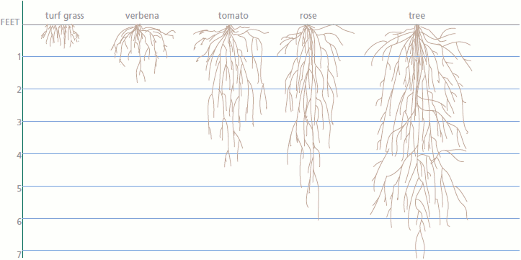
Most Piedmont native/naturalized plants will grow well with just the water that nature provides once they are well-established. Proper watering during establishment, usually for the first year, is still critical. Native plants also have deeper root systems than many common ornamentals, increasing the ability of clay soils to absorb and retain water. Natives thus reduce stormwater runoff and the associated water pollution. See Ornamentals and Natural Communities for detailed lists of plants suitable for our area.
 Mid America Regional Council, Kansas City
Mid America Regional Council, Kansas City
Site factors
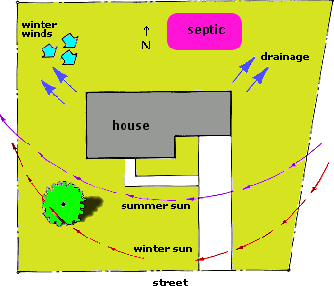
- Sun/shade
- Wind
- Drainage patterns
- Lawn size and shape
- Impervious surfaces
Sun/shade
By lowering the temperature, shade reduces water loss in two ways: decreased evaporation from the soil and decreased transpiration by plants. Shade can even reduce water loss when plants are in sun, because high shade over hard surfaces such as driveways reduces radiant heating of adjacent plant beds. Remember to choose shade trees that permit underplanting. A dense canopy prevents rain from penetrating to plants below, while shallow tree roots compete for water and nutrients
Seasonal differences in sun & shade
Shade varies with time of day and time of year. Areas in full sun in the summer may be in partial shade in spring and fall when the sun is at a lower angle in the sky.
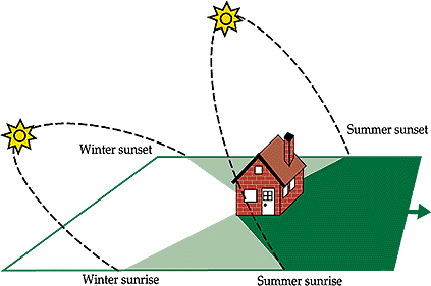 ◼ some shade all day
◼ some shade all day
◼ some shade in the morning or afternoon
◻ sun all day
Solar Pathfinder
The sun affects the temperature on each side of your home, and warmer temperatures create a drier environment. Note that you can modify temperature with plantings. Deciduous trees placed to the south and west of your home will create summer shade but permit winter light.
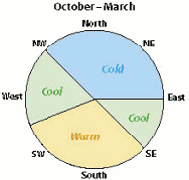
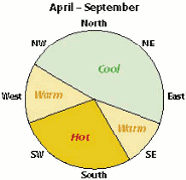
Types of shade
- Dense shade
Deepest of shade; under shrubs, porches, decks, dark corners, narrow passages between houses or buildings; ground is usually dark and dry. Plants will struggle under these conditions. Because plants need light to photosynthesize and produce food, only those with low metabolism can survive. - Full or deep shade
Total shade all day, no direct light but some indirect light; under low branching trees, trees with large leaves, and evergreen trees, sometimes the north side of buildings and fences, especially if a tree is nearby. Less than ¼ of the sky is visible through the tree canopy. - Part or medium shade
Shaded 4–6 hours in either the morning or afternoon; typically the edge of a wooded area or the west or east side of a house or fence. This area is best for plants that can take direct sun, but don’t like our summer heat. Select plants based on the type of sun the area receives. Generally, plants that prefer cooler conditions benefit from sun in the morning and afternoon shade during the heat of the day, while plants that love heat benefit from shade in the morning and hot sun in the afternoon. - Open, filtered or light shade
Under tall, high-branching trees with small leaves or near walls and fences without overhead branches; shaded 3–4 hours per day, receives bright indirect light plus considerable direct light.
Plant light requirements
- Shade–part sun
Plants prefer more shade than sun. For Orange County, this means morning sun, afternoon shade. Some shade lovers, like Aucuba japonica, have new leaves that are very sensitive to sunlight and should be planted where they will also receive shade in winter. - Sun–part shade
Plants prefer more sun than shade. Plants will tolerate light to medium shade for part of the day. - Full sun
Plants need at least 6 hours of full sun per day. With less, they will stretch, lean, flower intermittently, have sparse foliage or have disease issues.
Shade garden design
Shade gardens are subtle, employing differences in plant texture, height, form, and color to add visual interest.
- Texture
Texture can be coarse (large-leafed plants such as hostas or Aucuba) or fine, like many ferns and grassy perennials (mondo grass, liriope, and some sedges) or shrubs with small leaves (boxwood performs well in woodland gardens) or needle-like leaves (plum-yew). A contrast betweeen glossy leaves (Bergenia, Aucuba, evergreen Asarums) and matte leaves (Siberian bugloss, deciduous Asarum) is very effective. - Form
Weeping or rounded forms add a spacious feeling to plantings otherwise dominated by upright or horizontal, ground-hugging plant forms. - Color
Light colors — whites, cream, gold or pinks — stand out in the shade, while deep blues and purples tend to recede unless set off by a lighter, contrasting color. Red- or purple-leafed plants such as some Heuchera, Japanese maple or Loropetalum cultivars contrast well with both green or light-colored plant leaves. - Learn More
Wind
Water is lost from soil by evaporation and from plants by transpiration from leaf surfaces. Winds during winter and spring can be fierce and can cause significant evaporative loss from soil and transpirative loss from susceptible plants, as well as erosion from dormant garden areas. A properly designed windbreak reduces both evaporation and transpiration loss, as well as creating valuable habitat for wildlife.
Generally, a windbreak protects an area 10-15 times its average height.
 Lincoln Conservation District Windbreak considerations
Lincoln Conservation District Windbreak considerations
A windbreak actually should not be solid like dense evergreens or a board fence. A windbreak with 40–60% density in two staggered rows works well and should be comprised of a diversity of species to discourage diseases that can plague monocultures.
- As wind is deflected up and over a windbreak, low pressure on the downwind side draws the wind back down. This low pressure is stronger in dense windbreaks, drawing the wind down quickly and reducing the protected area size.
- Windbreaks with high density also tend to decay over time due to root competition and shading and any gap (like a path or driveway or plant decline) acts to funnel wind through at high velocity.
Lawn size & shape
Reducing lawn size saves more water than any other design strategy. Try using turf as an accent rather than a main feature. A small, thoughtfully designed and properly maintained lawn can provide as much beauty as a larger expanse with only a fraction of the water and maintenance requirements. At a minimum, turf should not be placed in narrow, hard to irrigate areas or where conditions are less than ideal — shrubs or ground covers are better choices for these areas.// Less Lawn, More Life
Impervious surfaces & slopes
Some simple changes can greatly reduce runoff in your yard. Instead of non-absorbent surfaces, try gravel, porous concrete, stepping stones bricks, flagstone or pavers on sand. Direct runoff from your roof onto absorbent areas like lawns or beds or create a rain garden. Eliminate bare soil using groundcovers or mulch and terrace steep slopes.
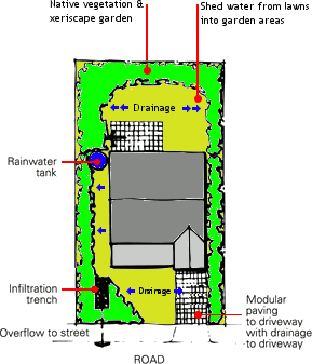
Installing a rain garden is a cost-effective and attractive way to enhance your home’s beauty and value while at the same time decreasing storm water runoff and pollution in local creeks and waterways. We created this short instructional video explaining the simple steps used to install a rain garden of any size.
- Rain Gardens
- How to Build a Rain Garden in Your Yard
- Backyard Rain Gardens
- Permeable Pavements, Green roofs & Cisterns
